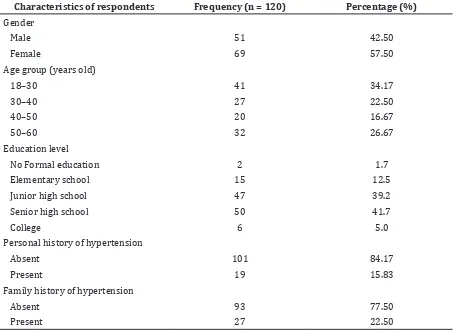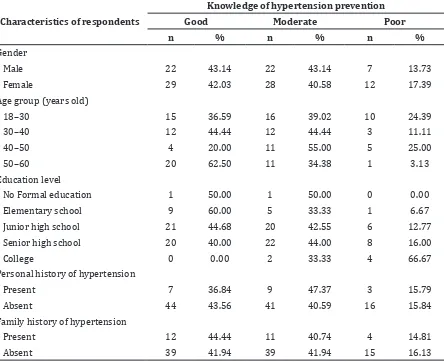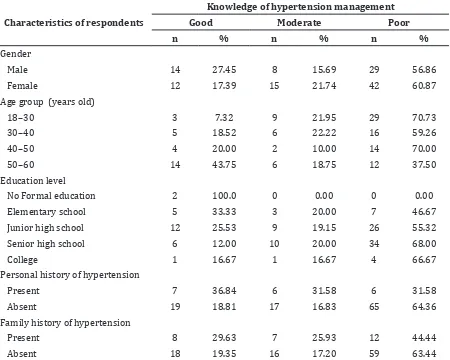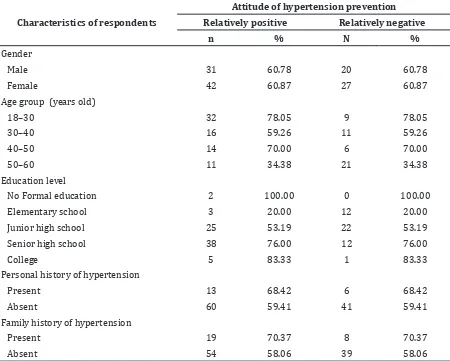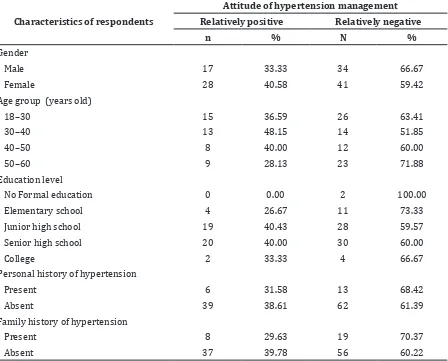222 AMJ June 2016
Knowledge and Attitude towards Prevention and Management of
Hypertension in Jatinangor Sub-district
Kartika Malahayati,1 Rudi Supriyadi,2 Herri S. Sastramihardja3
1Faculty of Medicine, Universitas Padjadjaran, 2Department of Internal Medicine Faculty of
Medicine Universitas Padjadjaran/Dr. Hasan Sadikin General Hospital Bandung 3Department of
Pharmacology and Therapy Faculty of Medicine Universitas Padjadjaran
Abstract
Background: There is an increase in prevalence of hypertension all over the world as well as Indonesia. Hypertension affects almost all body organs and systems. Hypertension prevention and management are influenced by knowledge and attitude towards the disease. The aim of this study was to assess knowledge and attitude towards prevention and management of hypertension.
Methods: This was a descriptive study with cross–sectional approach conducted in Jatinangor sub-district in 2013. Sample sizes were determined based on proportion of the case in population and precision estimates (95% confidence intervals). One hundred twenty respondents aged 18–60 year-old were selected from population using stratified random sampling method. Hypertensions knowledge and attitude were assessed using validated questioner as the scale measurement. Frequency of knowledge level was presented as three ordinal categories; good, moderate, and poor. Attitude of hypertension was presented as frequency in two categories; relatively positive and relatively negative.
Results: Out of 120 respondents administered the questioner, 42.50% had good knowledge; 41.67% had moderate knowledge; 15.83% had poor knowledge related to hypertension prevention and 21.67% had good knowledge; 19.17% had moderate knowledge; 59.17% had poor knowledge related to management of hypertension. Hypertension attitude of respondents were 60.83% relatively positive in topics of hypertension prevention and 39.17% in topics of hypertension management.
Conclusions: Respondents are knowledgeable about hypertension prevention but are less knowledgeable about its management. Respondents have relatively positive attitudes towards hypertension prevention. In the other hand, respondents have more relatively negative attitudes towards its management. [AMJ.2016;3(2):222–9]
Keywords: Attitude, hypertensions, knowledge, prevention, treatment.
Correspondence: Kartika Malahayati, Faculty of Medicine, Universitas Padjadjaran, Jalan Raya Bandung-Sumedang
Km.21, Jatinangor, Sumedang, Indonesia, Phone: +62 85279085993 Email: kartika.malahayati@gmail.com
Introduction
According to World Health Organization (WHO), in 2008, hypertension had prevalence
of 40% in worldwide adult population.1
Furthermore, the number of adults with hypertension in 2025 was predicted to increase 60% to a total of 1.56 billion adults.2 The other
studies report that hypertension is one of the leading causes of premature death worldwide,
accounting 7.5 million deaths, about or 12.8%
of the total of all annual deaths. This accounts
for 57 million Disability Adjusted Life Year (DALYs) or 3.7% of total DALYs.1,3,4
Hypertension is a common disease in Indonesia. The disease still occupies the seventh position of the top ten outpatients in hospitals
in 2010. The incidence of hypertension reached
80,615 cases in that year.5 According to Riset
Kesehatan Dasar (Riskesdas) Indonesia 2007, there are at least 31.7% of the total population, equivalent to 74 million people in Indonesia
have hypertension.6 In addition, hypertension
Prevention and treatment of diseases are form of health behavior that is a normal response to a health stimulus. There are three areas of health behavior, namely knowledge,
attitude, and practice. First is to find out the
stimulus, and then gives a response in the form of attitude, followed by practice and the application.
The purpose of this study was to assess hypertension knowledge and attitude of people who lived in Jatinangor sub-district related to prevention and treatment of the disease.
Methods
This was a descriptive study with a cross-sectional approach. This study had been
approved by Health Research Ethics
Committee with a letter numbered 212\UN6.
C2.1.2\KEPK\2013 to be conducted between
August–September 2013 in Jatinangor sub-district.
Hypertensions knowledge and attitude
was assessed using questioner as the scale
measurement. The final scale had 22 items
with four sub-dimensions of prevention-knowledge, prevention-attitude, management-knowledge, and management-attitude. In
order to determine qualification measured by
scale, validity and reliability of the questioner was pilot tested to 30 randomly–selected participants out of the respondents of the study.
Sample size was determined based on proportion of the case in the population
and precision estimates (95% confidence intervals). After being stratified based on
villages, respondents were selected from population using random sampling method. The inclusion criteria for respondent of this
study are aged between 18–60 year-old and lived in Jatinangor. One hundred twenty
respondents were involved in this study.
Statistical Product and Service Solution
(SPSS) version 16.0 for Windows and Microsoft Excel 2010 were used for data analysis. From
the analysis, knowledge of hypertension was
Table 1 The Distribution of The Study Group According to Various Demographic and Medical Characteristics of Respondents
Characteristics of respondents Frequency (n = 120) Percentage (%)
Gender
Male 51 42.50
Female 69 57.50
Age group (years old)
18–30 41 34.17
Elementary school 15 12.5
Junior high school 47 39.2
Senior high school 50 41.7
College 6 5.0
Personal history of hypertension
Absent 101 84.17
Present 19 15.83
Family history of hypertension
Absent 93 77.50
224 AMJ June 2016
divided into two sub-dimension, knowledge to prevention and knowledge to management of hypertension. The knowledge outcome measurement was the percentage of the accumulation score. This score then was put into three ordinal categories, good, moderate,
and poor. If the total right answer was 76–
100%, then knowledge of respondents would be categorized as good. If the total right answer
was 56–75%, interpretation of respondents’
knowledge about hypertension would be categorized as moderate. If the total right
answer was ≤55%, respondents’ knowledge about hypertension was classified as poor.
Attitude of hypertension was divided into two sub-dimension, attitude to prevention and attitude to management of hypertension. This variable was presented using ordinal measurement scale. Attitude measurement
in this study used a Likert scale, where each
response to an attitude questionnaire has a
composition degree from very negative to very
positive. Results of Likert Scale Model answers
were categorized in two categories, positive attitude and negative attitude. To be analyzed, the results were expressed in units of standard deviation of all respondents using a score-T, follows:
Description:
X = score of respondents on a scale of attitude to be converted into a score-T
= the mean score of all respondents s = standard deviation score group
Respondents’ attitude towards prevention
were relatively positive when the T-score is greater than the mean-T, while the relatively negative attitude were categorized when the T-score less than or equal to the mean-T.
Table 2 Knowledge of Hypertension Prevention Based on Characteristics of Respondents
Characteristics of respondents
Knowledge of hypertension prevention
Good Moderate Poor
n % n % n %
Gender
Male 22 43.14 22 43.14 7 13.73
Female 29 42.03 28 40.58 12 17.39
Age group (years old)
18–30 15 36.59 16 39.02 10 24.39
30–40 12 44.44 12 44.44 3 11.11
40–50 4 20.00 11 55.00 5 25.00
50–60 20 62.50 11 34.38 1 3.13
Education level
No Formal education 1 50.00 1 50.00 0 0.00
Elementary school 9 60.00 5 33.33 1 6.67
Junior high school 21 44.68 20 42.55 6 12.77
Senior high school 20 40.00 22 44.00 8 16.00
College 0 0.00 2 33.33 4 66.67
Personal history of hypertension
Present 7 36.84 9 47.37 3 15.79
Absent 44 43.56 41 40.59 16 15.84
Family history of hypertension
Present 12 44.44 11 40.74 4 14.81
Results
One hundred twenty respondents were included in this study. Of these, 57.5% were
female. The mean age of the respondents was
37.63 years. A personal history of hypertension was observed in 15.8% and family history in
22.5% respondents.
Out of 120 respondents administered the questioner, 42.50% had good knowledge
related to prevention of hypertension and
21.67% had good knowledge related to management of hypertension. About 41.67% and 19.17% had a moderate knowledge on
prevention and management of hypertension. Forty percent respondents knew that hypertension is a disease related to the
high blood pressure; 64.17% respondents
correctly answered the normal value of human blood pressure. Most of respondents were knowledgeable about prevention of
hypertension, accounting 97.5% respondents
believed hypertension can be prevented; 90% respondents knew that doing some exercise can prevent the hypertension; averagely
78.3% respondents agreed low salt diet and
low fat diet is a good prevention of the disease.
About 59.17% respondents had
poor knowledge about management of hypertension. Although 93.33% respondents believed that hypertension treatment is
very important, only 20.83% respondents
knew that hypertension treatment should be done over a lifetime. When respondents
were asked for more specific question
related to the management of hypertension,
72.5% respondents correctly answered that
hypertension patient need to consume anti–
hypertensive medicines and 40.83% knew
that non-pharmaceutical management is also
important to increase hypertensive patients’
health.
Results of hypertension attitude were
Table 3 Knowledge of Hypertension Management Based on Characteristics of Respondents
Characteristics of respondents
Knowledge of hypertension management
Good Moderate Poor
n % n % n %
Gender
Male 14 27.45 8 15.69 29 56.86
Female 12 17.39 15 21.74 42 60.87
Age group (years old)
18–30 3 7.32 9 21.95 29 70.73
Personal history of hypertension
Present 7 36.84 6 31.58 6 31.58
Absent 19 18.81 17 16.83 65 64.36
Family history of hypertension
Present 8 29.63 7 25.93 12 44.44
226 AMJ June 2016
expressed in units of standard deviation of all respondents using score-T. Mean-T for attitudes towards hypertension prevention
was 49.89 whereas mean-T for attitudes
towards hypertension management was 50.00.
From the analysis, it was known that 60.83%
respondents had relatively positive attitude
towards prevention of hypertension; 37.17%
respondents had relatively negative attitude towards hypertension. This value was much bigger than attitude value of hypertension
management; only 37.50% respondents were
categorized as having a relatively positive attitude. Sixty two percent respondents had a relatively negative attitude, primarily on adherence therapy patients have to follow and strict lifestyle changes.
Discussions
Death and disability that occurs in
hypertensive patients was mostly caused by its complications, such as cerebrovascular disease, ischemic heart disease, heart failure and kidney failure. Hypertension caused
54% mortality of stroke patients and 47% of
ischemic heart disease deaths. In addition, hypertension is called as silent killer due to its character that will not cause symptoms until complication appear.3,4 A lack of knowledge
about hypertension negatively influences patients’ awareness and behaviors, and is a
major obstacle in controlling the disease.7,8
Out of 120 respondents, 19 respondents (15.83%) had history of hypertension.
This number was a little bit higher than hypertension prevalence in Jatinangor sub-district in 2012 which is 9.61%.9
This study result shows that respondents were knowledgeable about prevention of hypertension, but were less knowledgeable about treatment and management of the
disease. Out of 120 respondents administered Table 4 Attitude of Hypertension Prevention Based on Characteristics of Respondents
Characteristics of respondents
Attitude of hypertension prevention Relatively positive Relatively negative
n % N %
Gender
Male 31 60.78 20 60.78
Female 42 60.87 27 60.87
Age group (years old)
18–30 32 78.05 9 78.05
Elementary school 3 20.00 12 20.00
Junior high school 25 53.19 22 53.19
Senior high school 38 76.00 12 76.00
College 5 83.33 1 83.33
Personal history of hypertension
Present 13 68.42 6 68.42
Absent 60 59.41 41 59.41
Family history of hypertension
Present 19 70.37 8 70.37
the questioner, 42.50% had good knowledge
related to prevention of hypertension and
21.67% had good knowledge related to
management of hypertension. This result contradicted to some other studies stated that people, especially in urban and sub-urban area, had tendency to have good knowledge of hypertension prevention as well as hypertension management.7,10
Generally, there were many views about
definition of hypertension; about 40% of our
respondents knew hypertension indicated by high blood pressure. Interestingly, there was a commonly held notion in population that hypertension might be indicated by excessive
worries, thinking or stress (55% respondents).
This was contrary to another similar study denying the presence of that notion in the population. From study conducted by Iyalomhe in sub-urban population, majority
of population (61%) knew exactly about definition of hypertension. 7
Based on age, the majority percentages
of respondents who had good knowledge
of hypertension prevention are on age >40 years, which is as much as 54%. However, for
knowledge of hypertension management there was a tendency that the younger the age, the higher the knowledge. This trend contradicted to the theory of knowledge formation. Age is one factor that affects the formation of knowledge, the older the age of a person, the more constructive he is in using the coping problems encountered.11
There was no compelling difference in level of knowledge of hypertension prevention
gratified based on respondent’s educational background. Yet, there were some inclinations
in level of hypertension management knowledge. The results of this study suggested that the lower educational level of respondents, the higher level of knowledge they must have. Based on further observation, it is known that most of respondents gathered the information about hypertension not from formal educational institution, but from
Table 5 Attitude of Hypertension Management Based on Characteristic of Respondents
Characteristics of respondents
Attitude of hypertension management Relatively positive Relatively negative
n % N %
Gender
Male 17 33.33 34 66.67
Female 28 40.58 41 59.42
Age group (years old)
18–30 15 36.59 26 63.41
Elementary school 4 26.67 11 73.33
Junior high school 19 40.43 28 59.57
Senior high school 20 40.00 30 60.00
College 2 33.33 4 66.67
Personal history of hypertension
Present 6 31.58 13 68.42
Absent 39 38.61 62 61.39
Family history of hypertension
Present 8 29.63 19 70.37
228 AMJ June 2016
the clinic of family health care attendance. This inclination also could be caused by the limitation of educational background
distribution in respondents’ variables.
Hypertension attitude of respondents were relatively positive in topics of hypertension prevention, but more negative in the topics of management of hypertension. This is similar to
another study conducted by Lukoschek which
stated that people have inclination to have more negative attitude towards management of hypertension though this inclination is
influenced by races and socio–demographic
factors.12
Seventy percent respondents who had personal history of hypertension strongly agreed that hypertension should be prevented. In contrast, when attitude towards management of hypertension were measured, only 29.63% of these respondents agreed to the lifestyle change as the treatment of hypertension. Some studies have reported that there is a strong correlation between personal histories of hypertension to the attitude of respondents.7,8 Oliveria et al.10 suggested those
people who have history of hypertension tend to give positive response towards both prevention and management of the disease. This difference might be happened because respondents of this study had different concept of hypertension treatment. Respondents had inclination to answer that hypertension only have to be treated until patients are cured. Unfortunately, until now, there is no curative treatment to cure hypertension. The treatments available nowadays are only able to control blood pressure and to prevent further complication of hypertension.3
This study is limited due to the ability of
researcher for the first time to do research so
there were still many shortcomings in data collecting, processing, interpretation and writing results of the research. Design used in this study was descriptive, so it was only able to describe phenomenon without the ability to
count the significance of variables for broader
results. In addition, although questioner used in this study has been validated, there were still some probabilities of informational bias because questioner consisted of two different scales, so itcould confuse the respondents who
filled it.
In conclusion, this study results suggest that respondents have good knowledge about the prevention of hypertension, but are less knowledgeable about the treatment of the disease. Hypertension attitude of the respondents are relatively positive in the topics
of hypertension prevention. On the other hand,
respondents have much more negative in the topics of management of hypertension.
This study suggested that it is better that the government together with all health care provider paying more attention in controlling hypertension by increasing
people’s knowledge and awareness towards
the disease. It is also important to conduct further analytical research to correct this
study’s limitations and broaden the scope of
research to result a better comprehension of hypertension knowledge and attitude.
References
1. WHO. Global status report on
noncommunicable diseases. Geneva: WHO
Press; 2010.
2. Chobanian AV, Bakris GL, Black HR,
Cushman WC, Green LA, Izzo JL, et al. Seventh
report of the joint national committee on prevention, detection, evaluation, and treatment of high blood pressure.
Hypertension. 2003;42(6):1206–52.
3. Whitworth JA, WHO, ISH. 2003 World
Helath Organization (WHO)/International Society of Hypertension (ISH) statement on
management of hypertension. J Hypertens.
2003;21(11):1983–92.
4. Lawes CMM, Hoorn SV, Rodgers A. Global
burden of blood-pressure-related disease,
2001. Lancet. 2008;371(9623):1513–8.
5. Kementrian Kesehatan Republik Indonesia.
Profil kesehatan Indonesia tahun 2011.
Jakarta: Kementrian Kesehatan Republik Indonesia; 2012.
6. Badan Penelitian dan Pengebangan Kesehatan Kementrian Kesehatan Indonesia. Riset kesehatan dasar Indonesia
2007. Jakarta: Kemenkes RI; 2010.
7. Iyalomhe GBS, Iyalomhe SI. Hypertension-related knowledge, attitudes and life-style practices among hypertensive patients in a sub-urban Nigerian community. J Public
Health Epidemiol. 2010;2(4):71–7.
8. Buendía J. Attitudes, knowledge and beliefs of patient about anti-hypertensive drugs.
Biomedica. 2012;32(4):578–84.
9. Dinas Kesehatan Kab. Sumedang. Profil
Puskesmas DTP Jatinangor tahun 2012. Jatinangor: Dinas Kesehatan Kab. Sumedang. 2013.
10. Oliveria SA, Chen RS, McCarthy BD,
Davis CC, Hill MN. Hypertension knowledge, awareness, and attitudes in a hypertensive population. J Gen Intern Med.
11. Jha N, Bajracharya O, Shankar PR.
Knowledge, attitude and practice towards medicines among school teachers in
Lalitpur district, Nepal before and after
an educational intervention. BMC Public Health. 2013;13:652.
12. Lukoschek P. African americans’ beliefs
and attitudes regarding hypertension and its treatment: a qualitative study. J Health
